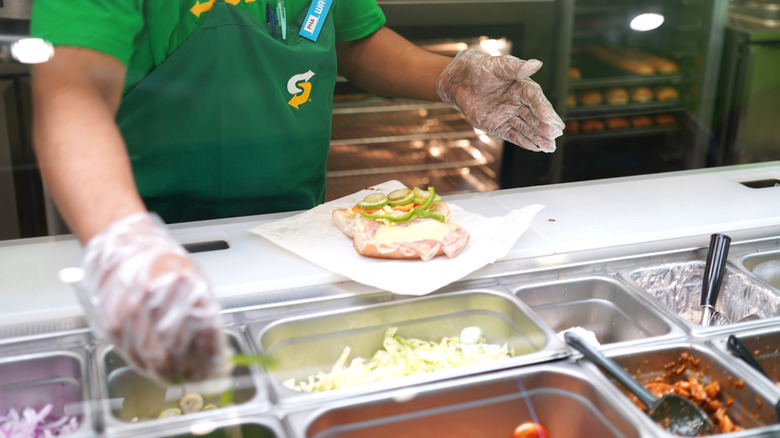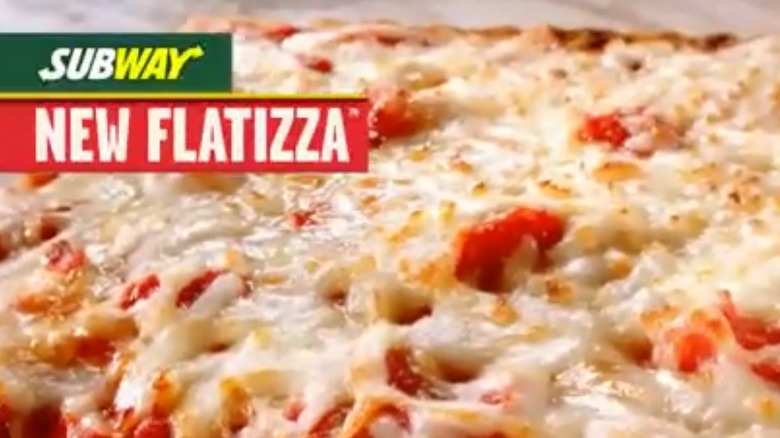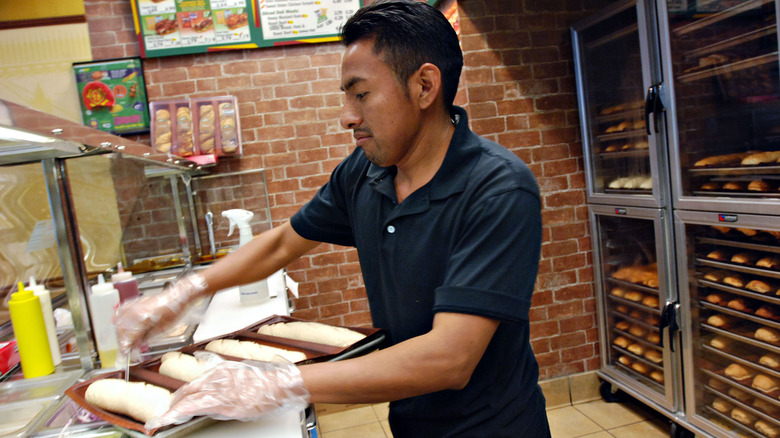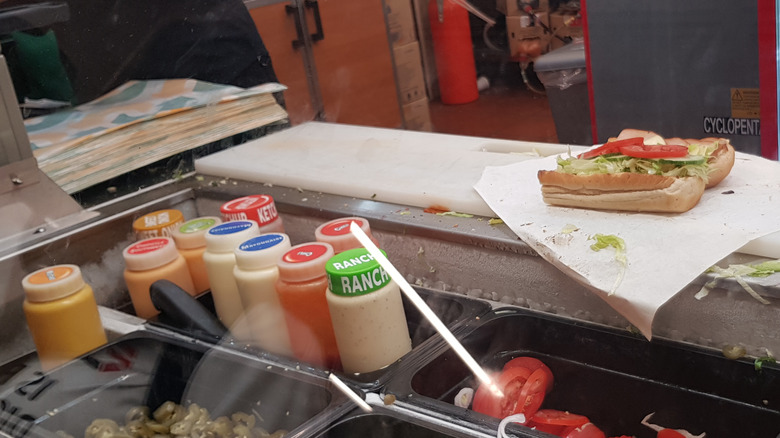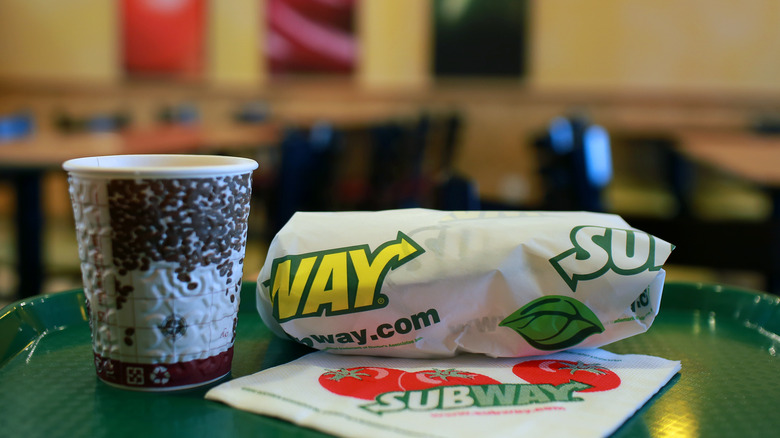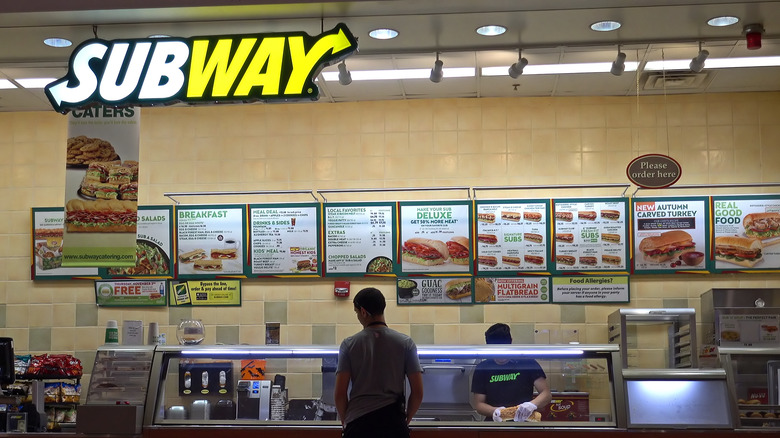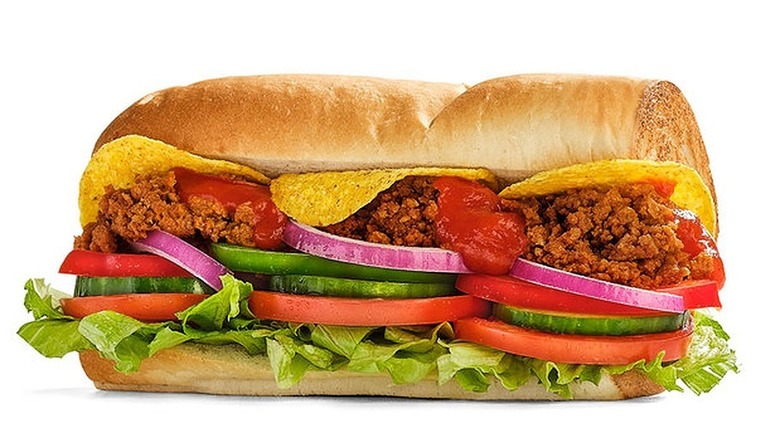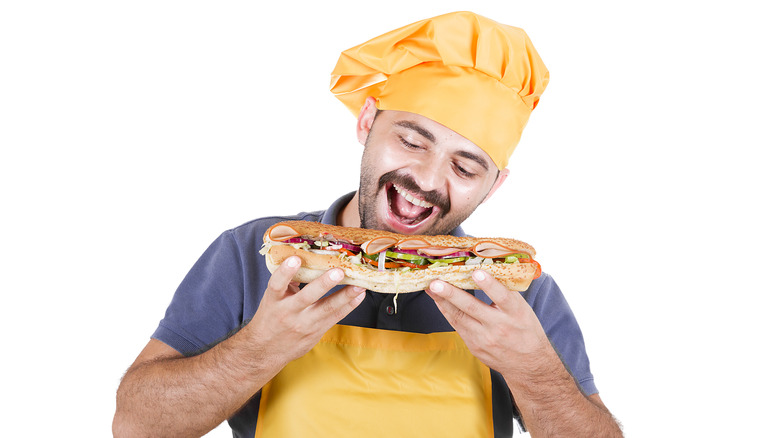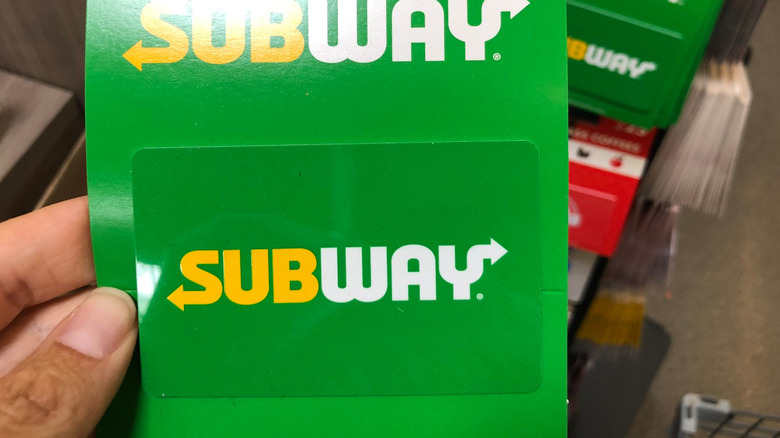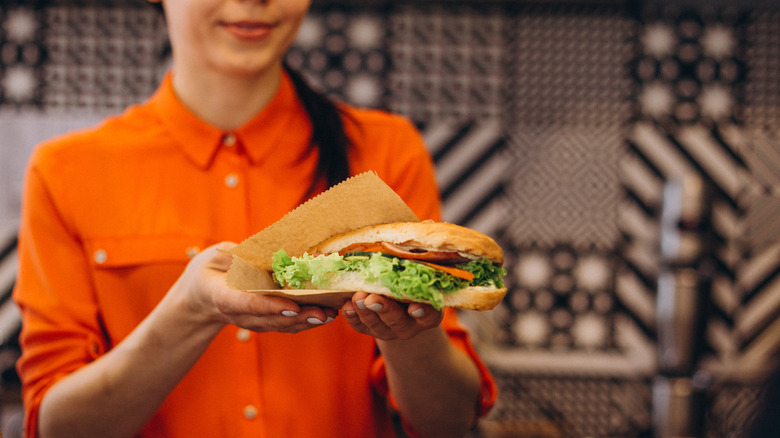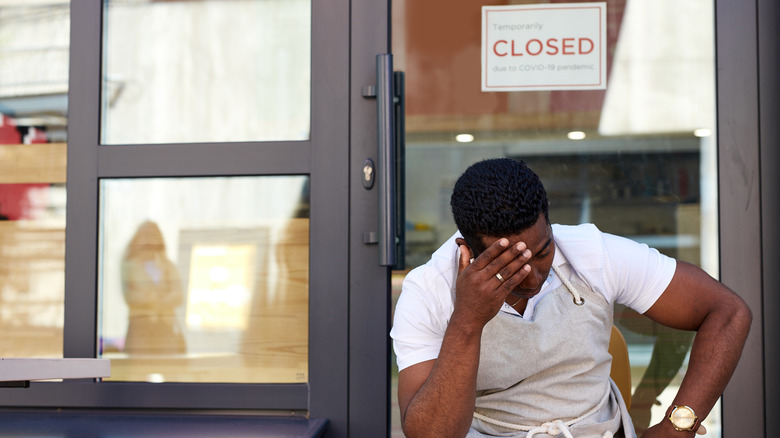The Biggest Flops In Subway's History
Over half a century ago, Fred DeLuca and Peter Buck opened a submarine sandwich shop called "Pete's Subway" in Bridgeport, Connecticut. By 2010, the business grew to more than 40,000 locations worldwide as fans devoured favorites such as the Subway Club, Spicy Italian, and Meatball Marinara. The franchise's road to (and from) success hasn't always been as smooth as its sandwich toppings, though. Plagued by scandals, including one lawsuit alleging their tuna isn't really tuna (Subway claims they use "wild-caught skipjack tuna regulated by the FDA"), the "Eat Fresh" enterprise began a downward spiral in the 2010s.
According to Restaurant Business, Subway is no longer the sandwich king: Its share of the limited-service sandwich market has taken a hit over the past decade. Sales challenges and restaurant closures have "cut its market share of the Top 500 sandwich chains to 28%" and forced it into a negative growth trajectory surpassed only by Einstein Bros. Bagels. Meanwhile, Jersey Mike's sales have tripled.
Instead of focusing on fresh ingredients and staying competitive, Subway has initiated the equivalent of 29 litigation actions (mostly arbitrations) per 1,000 franchisees, compared to 1.4 actions for McDonald's, Dunkin' Donuts, Pizza Hut, Burger King, and Wendy's combined, the New York Times reports. Not to mention, they've made some pretty big blunders, from menu items to ads, corporate policies to publicity initiatives. Keep reading to learn more about how some of Subway's heroes turned into zeroes.
Flatizzas fell flat
Most people wouldn't head to a burger joint for a taco; likewise, ordering pizza at a sandwich place sounds just as sacrilegious. Still, in 2014, Subway launched the Flatizza: a mini flatbread pizza, available in pepperoni, veggie, spicy Italian, and plain cheese varieties. The pies initially cost two for $5, but eventually increased to $3.50 each. Subway's descriptions of Flatizzas sounded downright delicious, calling the cheese version "an exciting combination of warm marinara sauce and bubbly mozzarella cheese on a toasty flatbread." But the Flatizza didn't deliver. A reviewer on grubgrade.com wrote: "Ragu Pizza Quick [Sauce] Vibe. Overall GrubGrade: 6.25/10."
The Flatizza went the way of the dodo bird and is no longer a part of Subway's menu lineup. Those hankering for a pizza-inspired sub can order one off their "secret menu" (per Wide Open Eats). The saucy sub includes marinara sauce, pepperoni, mozzarella cheese, parmesan cheese, and your choice of veggies on a toasted Italian bun.
Easy on the bread chemicals and sugar
In 2014, Subway received a great deal of bad publicity and pressure to remove azodicarbonamide, a chemical compound also found in yoga mats, from its bread recipe. As it turns out, though, the chemical is found in nearly 500 common brands and products (per the Environmental Working Group). Eventually, Subway phased out the ingredient, but their slow response was a flop in itself that was difficult to recover from.
Adding to the bread chemical debacle, an Irish court ruled that, due to its high sugar content (more than five grams per six-inch sub roll), the bread shouldn't even be classified as bread at all, but rather as a confectionary. The ruling, citing Ireland's Value-Added Tax Act of 1972, stated that the sugar and fat in the bread "should not exceed 2% of the weight of flour included in the dough." But a Subway spokesperson protested, "Subway's bread is, of course, bread. We have been baking fresh bread in our stores for more than three decades and our guests return each day for sandwiches made on bread that smells as good as it tastes."
Subway now boasts five mainstay bread choices (9 Grain Wheat, Multi-Grain Flatbread, Italian, Italian Herbs & Cheese, and regular Flatbread), with select locations offering Hearty Italian, 9-Grain Honey Oat, Jalapeño Cheese, Monterey Cheddar, Parmesan Oregano, Roasted Garlic, Rosemary & Sea Salt, Rye Bread, and Gluten-Free Bread. Their website invites customers to "follow the smell of our baking bread," so perhaps their bread brouhaha has died down — but it's fascinating that the foundational element of Subway's product has threatened multiple times to be their undoing.
Sayonara, sauces
Certain sauces and dressings have disappeared from Subway's menu because they failed to capture customers' attention and just weren't being requested much. Italian and Sriracha were among those discontinued, and a few others are potentially on their way out. According to an employee in a Subway Reddit thread: "Our store has not discontinued its Caesar dressing, but we barely sell one sandwich with it per week if it's bottled, so it's often the one dressing that expires and gets tossed out."
A Ranker survey of favorite Subway toppings lists mayonnaise (#5), Chipotle Southwest Sauce (#13), Sweet Onion Sauce (#14), and mustard (#20) as fan favorite sauces. Zesty Italian is #26, and Caesar didn't even make the list, so most customers probably won't notice their absence. On the other hand, some customers will go to great lengths to champion their Subway sauces: A patron of Subway India started an online petition at change.org to bring back the franchise's barbeque and Caesar sauces. The petition didn't get very far, though, garnering only 15 supporters — landing these and a handful of other sauces firmly in flop territory.
Subway breakfast was a bust
As of 2018, Subway no longer required franchisees to serve breakfast. Low interest was to blame: More than 40% of Subway customers didn't stop there for breakfast, and 19% didn't even know they offered the morning meal, a Bloomberg study revealed. Other reasons cited for change include staffing shortages and formidable breakfast competitors such as Taco Bell, Dunkin' Donuts, and McDonald's. In an email to Business Insider, James Walker, vice president of Subway North America, said, "We are continuously evaluating every consumer touchpoint (including hours of operation, menu, day part, etc.) and making adjustments as needed to help Subway franchisees be more successful."
Ultimately, each individual business owner has the final say on whether breakfast stays or goes, but Subway's official menu makes no mention of bacon and eggs. It probably didn't help much that the eggs were shipped to franchisees in the form of floppy, unappetizing disks (per Business Insider). Some fast food restaurants' breakfast offerings are arguably the best part of their menu. Unfortunately, in Subway's case, it's just the opposite.
Sandwich shuffle
In 2020, Subway made the unpopular decision to stop selling both roast beef and rotisserie chicken, reportedly because they were the two most expensive meat toppings on their menu. The menu cuts were a big flop, though, with angry franchisees and customers flooding Subway with complaints. Rotisserie chicken loyalist Joseph "The Demon" Albanese cried "fowl," tweeting, "@SUBWAY: Discontinuing rotisserie chicken? Seriously? Your own workers actually said today 'do not know why, stupid move with one of our top sellers.' Probably won't care just thought you might want to know what is a pretty dumb move."
The meaty favorites weren't gone for long, though. An article in Nation's Restaurant News reports that roast beef and rotisserie chicken are back on Subway's menu as of late 2021. Not only have the favorites returned, the chain is now offering new chicken options including a Chicken & Bacon Ranch with bacon, Monterey cheddar cheese, and peppercorn Ranch sauce, as well as a Baja Chicken & Bacon featuring chicken, pepper Jack cheese, and a new Baja Chipotle sauce. Their new roast beef sub is made with USDA Choice Angus roast beef, lettuce, tomatoes, spinach, green peppers, onions, and cucumbers. Hopefully they don't make the mistake of removing this menu item again.
Taco TKO
Fans of taco creations in the UK will have to run for the border, not Subway, since Britain-based franchisees removed taco beef from their offerings in 2019. A Subway spokesperson explained, "We're adding lots of exciting new menu options and there are more to come. This meant we had to say goodbye to some of our less-loved ingredients." Taco-meat enthusiasts can order a Subway taco (billed as "a sub filled with ground beef and salsa") in Japan, where it debuted in 2015. Foodbeast's take on this taco, however, wasn't so flattering, describing it as "sketchy ground beef, covered with a ton of lettuce, wrapped in flat bread."
USA Today writer Nick Swartz called the creation "the worst taco of all time," before specifying that "it's not even a taco." Japan isn't the only place in the universe one can try their luck at finding an adequate Subway taco. "Subway Skippergata" in Oslo, Norway calls their version "A TexMex inspired sub with taco flavoured minced chicken and nachos. Superb with salsa and Rømme sauce." "Rømme" means sour cream in Norwegian (we looked it up — you're welcome). Overall, this sandwich doesn't look too bad. But it does prove that you may have to travel the world to find an adequate taco (or taco-esque offering) from Subway, because in most locales, it seems to be a bust.
Five dollar footlong fail
Over the years, Subway has touted its $5 footlong deal as a means to stand out from the competition (can't you just hear the incessant "five-dollar footlong" chant from their commercial?). The last time the chain did a big push for the promotion was in 2020, but it only lasted a few weeks (per Restaurant Business). The online industry magazine cited poor timing (during the pandemic, when many were out of work), and a lack of franchisee support (only 71% participated in the promotion) as reasons the promotion fizzled.
As if removing the $5 deal weren't enough, Subway had also recently battled yet another lawsuit claiming their footlongs didn't measure up to their name and fell short of 12 inches. Apparently some footlongs only measure between 11 and 11.5 inches. The courts rejected the lawsuit, though. "It was difficult to prove monetary damages, because everybody ate the evidence," the plaintiff's co-lead attorney, Thomas Zimmerman, remarked.
But really, Subway had already strayed from the $5 footlong model long before their failed promotional event. Most Subway sandwiches are now priced at $6 and up; considering rising labor and operation costs, not to mention inflation, it wasn't sustainable to keep selling them for a Lincoln. It seems the $5 footlong, once synonymous with Subway's image, was always doomed to fail.
Subway club con
Subway regulars may recall a "Subway Club" punch card that allowed them to earn rewards (such as a free sub) after a certain number of visits. Cardholders would receive one free 6- or 12-inch sub free after they earned six punches for either (buy six of either size, get one free). A drink purchase (any size) was also required, and double meat, extra cheese, bacon, and avocado cost extra.
Although many may have accrued stamps worthy of a freebie, the club was discontinued in 2005 due to fraud. Tech-savvy swindlers were creating fake punch cards so they could abuse the rewards program. Some were even selling the cards on eBay, Wired reports. Fivestars Insights deemed Subway Club a "loyalty program blunder," condemning the paper cards as "easy to copy with photo-altering software." Subway now offers MyWay Rewards, an app allowing customers to earn rewards such as free cookies, free delivery, and buy one, get one free deals.
Dead giveaway
As part of Subway's Eat Fresh Refresh initiative, they tried to give away one million Turkey Cali Fresh subs (a brand new, "fresher" offering) July 13, but the promotion fizzled. The Takeout reports that some franchisees only gave away four free sandwiches, calling the PR stunt "a massive disaster, because nobody wanted the free Subway sandwiches."
In a review of some of the company's revamped menu items, New York Post food critic Steve Cuozzo called them "just as vile as the old ones," giving two thumbs down to the Turkey Cali Fresh and Steak Cali Fresh subs: "Chunks of mealy 'steak' looked and tasted like Fourth of July barbecue leftovers. Oven-roasted turkey is 'sliced deli thin,' but the flavor's even thinner, tasting more like paper than poultry. Hickory-smoked bacon on both sandwiches was a gristly, flavorless affair beyond rescue by a smear of smashed avocado. The only redeeming element was decent mozzarella from 'award-winning cheesemakers in Wisconsin,' once I found it beneath a heap of spinach, gummy sauces and laughably lame tomato slices."
Ouch! Those words hurt, but there's hardly a more scathing indictment of these products than not being able to get rid of them even when you're handing them out for free.
Furious franchisees
From removing popular menu items to forcing restaurant owners to sell shoddy sandwiches, Subway franchisees have frequently expressed their frustration with the company's choices. In an open letter to Elizabeth DeLuca, the widow of Subway cofounder Fred DeLuca, more than 250 franchisees said their Subway dream "turned into a nightmare. We didn't understand that language in our Franchise Agreements was written in a way so that Subway could change the rules on us at any time, without notice, for anything."
Business owners, aka important Subway brand ambassadors, listed six requests such as "Franchisees should have the right to source fresh vegetables every day and offer higher quality ingredients when they are available," and "Any change to our Franchise Agreements must be mutually agreed upon."
In yet another foolish move, Subway recently announced new rules pertaining to when stores can close, requiring them to remain open during a snowstorm, electrical outage, or terrorist attack. If franchisees violate these rules and close down more than once per year (barring an "act of God," per Business Insider), they might forfeit their ownership — and if they don't agree to surrender their business should the corporation demand it, Subway will increase their royalties to 10% on that location. If you asked Subway franchisees and employees about the biggest flop in company history, they might say it's the long track record of alienating and frustrating franchise owners. A company's people are, after all, the most important ingredient in its success.
